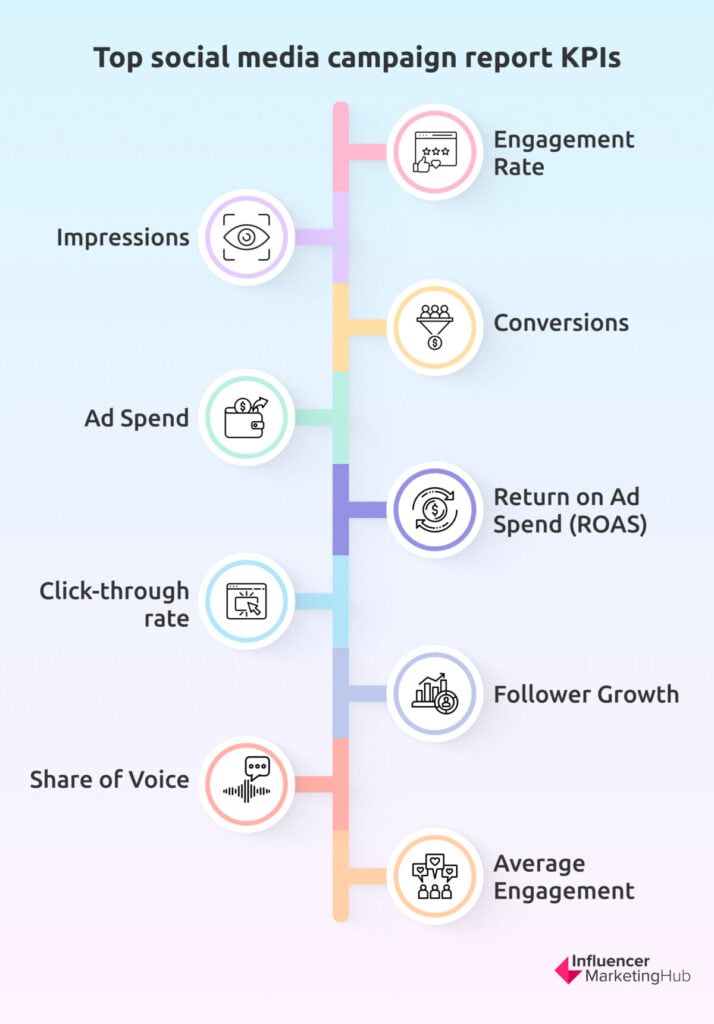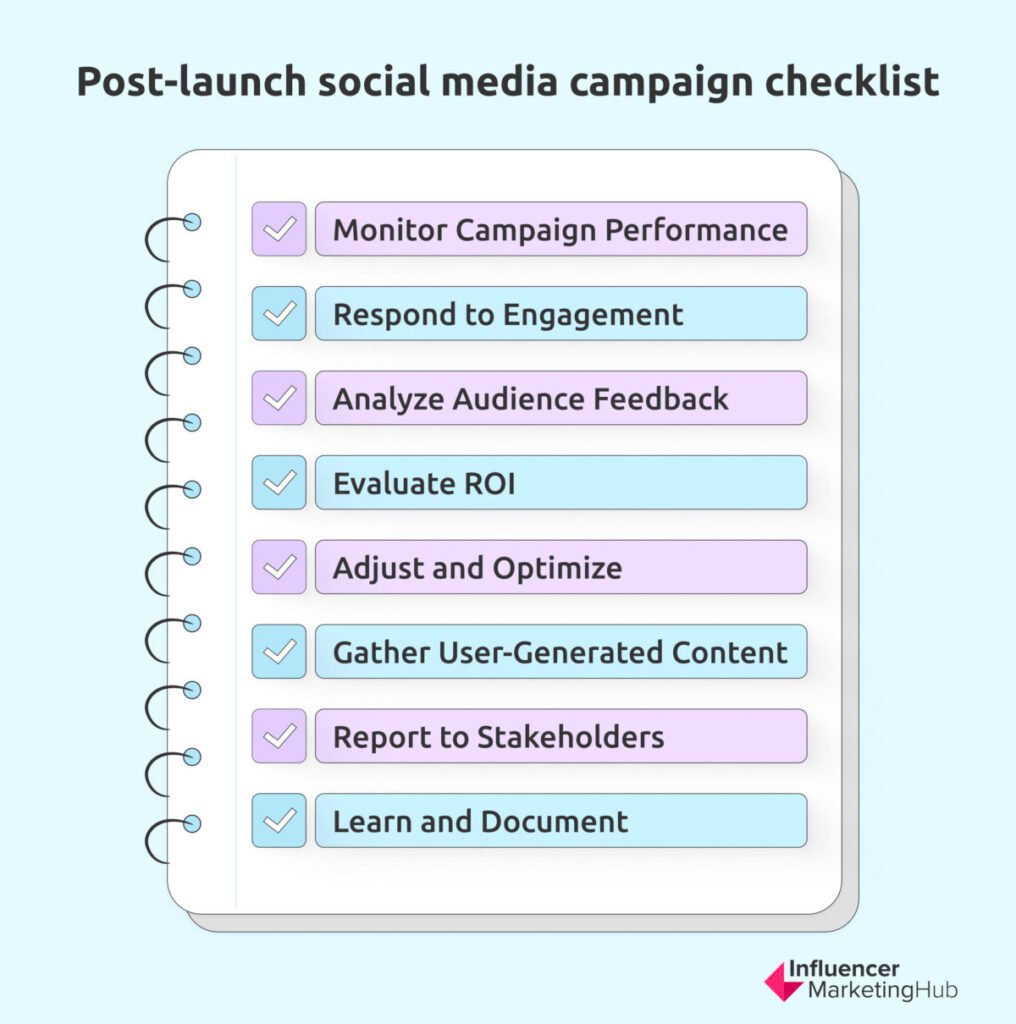You spent months planning a social media campaign and it's now finally launched. How well did it do? Initially, you'll look at engagement, such as views, likes, and comments. But does this really determine the success of your campaigns?
Not if it doesn't translate to leads and sales.
The best way to gauge the effectiveness of a social media campaign is to create a post-campaign social media report. Here's how to do it.
From Data to Strategy: Leveraging Post Campaign Social Media Reports for Future Campaigns:
What is a social media report?
A social media report is a comprehensive document that provides an overview of a company's social media performance and outcomes. It allows businesses to evaluate the effectiveness of their social media strategies and campaigns.
The main purpose of a social media report is to present data and insights that help analyze and improve the company's social media presence. It highlights key metrics and performance indicators to measure the success of social media efforts in meeting business goals.
Why use a social media campaign report?
Creating a report after running a social media campaign helps companies understand how their campaigns are performing. Here are several ways a social media campaign report can help you post campaign:
- Evaluate the success of your social media campaigns: A social media campaign report allows you to measure the performance of your campaigns against key metrics. For example, you can track engagement rate, follower growth, and share of voice to understand if your campaigns are resonating with your target audience.
- Track the impact of social media on larger company initiatives: A social media campaign report helps you evaluate how your social media efforts contribute to larger business goals. For instance, you can measure the impact of your social media campaigns on website traffic and conversions through Google Analytics.
- Show transparency and encourage cross-company alignment: By sharing a social media campaign report with stakeholders, you can communicate the effectiveness of your social media strategy and demonstrate the value of social media activities. This encourages collaboration and alignment between marketing teams and other departments within the organization.
- Identify areas for improvement and actionable insights: A social media campaign report provides valuable insights into the type of content that resonates with your audience and the social platforms that drive the most engagement. For example, you can analyze the performance of different social media posts to optimize your content strategy and overall marketing efforts.
By leveraging a social media report, you can make data-driven decisions to enhance your social media marketing strategy and drive better results.
What should your social media report include?
When it comes to measuring the success of your social media campaigns, a comprehensive social media report is crucial. This report provides valuable insights into the performance of your social media activities, allowing you to assess the effectiveness of your strategies and make data-driven decisions for future campaigns. In order to create a compelling social media report, there are several key components that should be included. From an overview of your social media presence to an analysis of engagement metrics and actionable insights, let's take a closer look at what your social media report should include.
1. Overview of social media presence
Begin your report by providing a clear overview of your social media presence. This should include a breakdown of the social media platforms you're active on, such as Facebook, Instagram, Twitter, LinkedIn, and any other relevant channels. Then specify the number of followers or fans you have on each platform and highlight any significant changes in follower growth over the reporting period. This section sets the context for the rest of the report and provides an understanding of your current social media reach.
2. Analysis of engagement metrics
Engagement metrics assess the success of your social media efforts. Include metrics such as likes, shares, comments, and retweets to gauge the level of audience interaction with your content. Calculate the average engagement rate for each platform by dividing the total engagement by the number of posts, providing a snapshot of how effectively you're connecting with your target audience. This section should also highlight any notable trends or patterns in engagement over time, allowing you to identify what type of content resonates best with your audience.
3. Evaluation of Key Performance Indicators (KPIs)
To measure the effectiveness of your social media campaigns, define and track key performance indicators (KPIs). These KPIs should be aligned with your business goals and reflect the specific outcomes you aim to achieve through your social media efforts.
For example, if your goal is to increase brand awareness, relevant KPIs may include reach, impressions, or share of voice. Include an evaluation of your KPIs within the report, along with a comparison to previous months or benchmarks, to assess the progress and impact of your social media marketing strategy.
4. Actionable insights and recommendations
The value of a social media report lies in its ability to provide actionable insights. So draw upon the data collected in the previous sections to identify trends, patterns, and opportunities for improvement. This section should identify what's worked well and what can be optimized in future campaigns.
For example, if you find that video content consistently generates higher engagement rates, consider allocating more resources towards video production. These insights should be accompanied by clear and specific recommendations for future social media strategies, allowing you to continually refine and optimize your efforts.
Tracking and analyzing the right metrics will provide a deeper understanding of the impact of your social media campaigns and make informed decisions to drive future success.
What are the best social media campaign report KPIs?
Measuring the effectiveness and success of your social media campaigns, requires tracking right key performance indicators (KPIs) in your campaign report. Unfortunately, some brands get caught up with vanity metrics or metrics that don't directly impact their company goals.
So which KPIs you track will differ based on your campaign's mission. If you're unsure of what to monitor and analyze, we put together a list of KPIs that are commonly found in social media campaign reports:

- Engagement Rate: This metric measures the level of interaction and engagement your audience has with your social media posts. It includes likes, comments, shares, and clicks on your content.
- Impressions: Impressions indicate the number of times your content has been displayed to users. It provides insights into the reach and visibility of your campaign.
- Conversions: Tracking conversions helps you measure the number of users who completed a desired action, such as making a purchase or signing up for a newsletter, as a result of your social media campaign.
- Ad Spend: This KPI helps you evaluate the cost-effectiveness of your campaign by measuring the amount of money spent on social media ads.
- Return on Ad Spend (ROAS): ROAS calculates the revenue generated as a result of your ad spend and indicates the profitability and success of your campaign.
- Click-through rate: This KPI measures the number of clicks on a particular link or CTA (call-to-action) on your post. It provides insights into the effectiveness of your campaign and its ability to drive desired actions.
- Follower Growth: Tracking the growth in your follower count is important as it indicates the effectiveness of your efforts in attracting and retaining a target audience.
- Share of Voice: This metric measures your brand's presence and visibility in comparison to your competitors on social media platforms. It provides insights into the reach and impact of your social media activities.
- Average Engagement: The average engagement metric calculates the average number of likes, comments, and shares per post. It shows how well your content resonates with your audience.
By including these KPIs in your social media campaign report, you can gather valuable insights and make data-driven decisions to optimize your future campaigns.
Checklist for what to do after launching a social media campaign
After launching a social media campaign, it’s important to have a checklist of tasks that should be completed in order to monitor the success of your efforts. Here is a checklist for what to do after launching a social media campaign:

- Monitor Campaign Performance:
- Track key metrics such as engagement, reach, impressions, clicks, and conversions.
- Use social media analytics tools to gather data and insights.
- Compare the campaign's performance against your goals and benchmarks.
- Respond to Engagement:
- Engage with users who have commented, liked, or shared your campaign posts.
- Respond to questions, comments, and feedback in a timely and professional manner.
- Thank users for their support and participation.
- Analyze Audience Feedback:
- Review comments, direct messages, and mentions to understand audience sentiment.
- Take note of any common themes or concerns raised by your audience.
- Use this feedback to improve future campaigns and address any issues.
- Evaluate ROI:
- Assess the campaign's return on investment (ROI) by comparing the cost of the campaign to the achieved results.
- Determine if the campaign met its objectives and if it generated the desired outcomes.
- Calculate the campaign's impact on key performance indicators (KPIs) and business goals.
- Adjust and Optimize:
- Analyze the campaign's performance data to identify areas for improvement.
- Make necessary adjustments to optimize future campaigns.
- Experiment with different content formats, messaging, targeting, or platforms to enhance results.
- Gather User-Generated Content:
- Identify and collect user-generated content (UGC) related to your campaign.
- Seek permission to repurpose UGC in future marketing efforts.
- Showcase UGC on your social media channels to foster engagement and build trust.
- Report to Stakeholders:
- Prepare a comprehensive report on the campaign's performance, including key metrics, insights, and outcomes.
- Share the report with relevant stakeholders, such as management, clients, or team members.
- Highlight the campaign's successes, challenges, and recommendations for future campaigns.
- Learn and Document:
- Document key learnings and insights from the campaign.
- Keep a record of successful strategies, tactics, and creative elements for future reference.
- Use this documentation to inform and improve future social media campaigns.
Remember, every campaign is unique, so feel free to adapt this checklist to suit your specific needs and goals.
Tools to use to track and analyze social media campaigns post-launch
It's time to track ana analyze the performance of your latest social media campaign. Which tools should you use? Here are some of our top recommendations:
- Google Analytics: Google Analytics is one of the best tools for monitoring website traffic and conversions from social media campaigns. It provides detailed reports on session duration, pageviews, and more.
- BuzzSumo: BuzzSumo is a powerful tool for tracking the performance of your content across social media channels. It gives you insights on which content is performing best and allows you to compare it to other campaigns.
- Sprout Social: Sprout Social provides detailed analytics and tracking tools that can be used to analyze the success of your social media campaigns. It helps you track engagement, growth, and conversion rates.
- Brandwatch: Brandwatch is a tool that provides comprehensive insights into how your brand is performing across different social media platforms. It helps to identify key trends and topics related to your brand.
- Socialbakers: Socialbakers is an analytics tool that allows you to monitor the performance of your campaigns across different social media platforms. It helps you to track conversations, engagement rates, and impressions.
- Buffer: Buffer is a tool that allows you to schedule posts and track the performance of your campaigns on multiple social media networks. It helps you identify which posts are performing best and optimize future campaigns accordingly.
- Hootsuite: Hootsuite is a social media management platform that provides detailed analytics and reporting for your campaigns. It helps you to track engagement, reach, and followers.
- Followerwonk: Followerwonk is a tool that helps you to analyze Twitter followers and optimize your content strategies accordingly. It gives insights into the demographics of your followers and allows you to compare them to other brands.
- Emplifi: Emplifi is a tool that helps you identify which of your followers are the most influential and active on social media. It provides detailed insights into their engagement rates and demographics.
- Rival IQ: Rival IQ is an analytics platform that allows you to monitor the performance of your campaigns in comparison to your competitors’ campaigns across multiple social media channels.
- Mention: Mention is a real-time social media monitoring tool that allows you to track campaigns across multiple networks. It provides insights into the conversations happening about your brand, and helps to identify influencers and trends related to your campaigns.
Start building social media reports to improve future campaigns
The best way forward is to understand what's worked for your brand in the past. And the same holds true for your social media campaigns. Keeping track of and analyzing each campaign you launch will keep you team on track to meeting business goals.
With the tips in this guide, you can begin building post-campaign social media reports that reveal the good, the bad, and the ugly so you can continue evolving your social media strategy that results in success.


